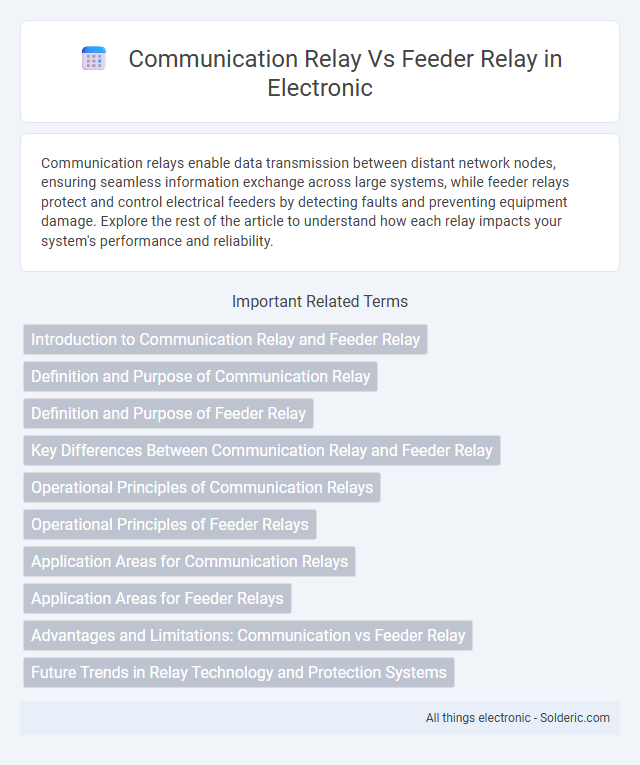Communication relays enable data transmission between distant network nodes, ensuring seamless information exchange across large systems, while feeder relays protect and control electrical feeders by detecting faults and preventing equipment damage. Explore the rest of the article to understand how each relay impacts your system's performance and reliability.
Comparison Table
| Feature | Communication Relay | Feeder Relay |
|---|---|---|
| Primary Function | Facilitates data transmission between communication devices | Protects and controls power feeder lines in electrical networks |
| Application | Telecommunications, network signal amplification | Electrical substations, distribution feeders |
| Signal Type | Data, voice, or digital signals | Electrical current and voltage signals |
| Operation | Repeats or amplifies communication signals | Monitors and trips circuits during faults |
| Key Components | Transceiver, amplifier, antenna | Current transformers, voltage transformers, trip units |
| Protection Scope | Not applicable | Short circuit, overload, earth fault protection |
| Response Time | Variable, depends on communication protocol | Fast, typically milliseconds to prevent damage |
Introduction to Communication Relay and Feeder Relay
Communication relays serve as essential nodes in telecommunication networks, enabling signal transmission over long distances by receiving and retransmitting signals to maintain data integrity and network efficiency. Feeder relays, integral to power distribution systems, detect abnormal conditions such as faults or overloads on feeder lines, triggering protective measures to isolate and safeguard electrical circuits. Both relay types optimize system performance by ensuring reliable signal or power flow while preventing failures and minimizing downtime.
Definition and Purpose of Communication Relay
Communication relay refers to a device or system that transmits signals between different communication nodes, facilitating data exchange over long distances or complex networks. Its primary purpose is to ensure continuous, reliable connectivity by amplifying, converting, or repeating signals to overcome transmission loss or obstacles. Unlike feeder relays, which manage electrical power distribution and protection within a feeder line, communication relays focus exclusively on information transfer and network integration.
Definition and Purpose of Feeder Relay
A feeder relay is an electrical protective device designed to monitor and safeguard feeder lines by detecting faults such as overloads, short circuits, and earth faults. Its primary purpose is to isolate faulty sections to prevent damage to the network and maintain system stability. You rely on feeder relays to ensure uninterrupted power distribution and protect downstream equipment from electrical faults.
Key Differences Between Communication Relay and Feeder Relay
Communication relays primarily manage data transmission between systems, ensuring reliable and secure signal transfer across networks, while feeder relays focus on protecting and controlling electrical feeders by detecting faults and isolating sections in power distribution. Communication relays operate within telecommunication and data networks, emphasizing signal integrity and timely communication, whereas feeder relays are integral to electrical grid stability, monitoring current, voltage, and fault conditions to prevent outages. Understanding your system's needs will help determine whether communication or feeder relays best optimize performance and safety in your infrastructure.
Operational Principles of Communication Relays
Communication relays operate by receiving signals from a source and retransmitting them over extended distances using wireless or wired channels, ensuring signal integrity through amplification and error correction techniques. They function by establishing a communication path between distant network nodes, often employing protocols like HDLC or TCP/IP to manage data framing and error detection. Unlike feeder relays that primarily protect power lines, communication relays optimize data transmission efficiency and reliability in telecommunication networks.
Operational Principles of Feeder Relays
Feeder relays operate by continuously monitoring electrical parameters such as current and voltage in distribution feeders to detect faults or abnormalities. These relays use time-current characteristics and directional sensing to isolate faulted sections promptly, minimizing disruption to the power system. Your protection scheme relies on feeder relays to enhance system reliability by ensuring quick and selective fault clearance.
Application Areas for Communication Relays
Communication relays are primarily used in long-distance and satellite communication systems where signal transmission over vast distances requires reliable data transfer and minimal latency. These relays are essential in aerospace, military, and telecommunications industries to ensure continuous connectivity and signal integrity. Your network infrastructure benefits from communication relays when handling complex data exchanges across remote or challenging environments.
Application Areas for Feeder Relays
Feeder relays are primarily applied in power distribution networks to protect feeders from faults such as short circuits and overloads, ensuring the continuous and reliable delivery of electricity to end-users. These relays are crucial in industrial plants, substations, and commercial buildings where feeder lines carry significant load currents, enabling quick fault detection and isolation to minimize damage and downtime. Their application areas extend to urban and rural power grids, where they enhance system stability and prevent cascading failures by isolating faults in specific feeder segments.
Advantages and Limitations: Communication vs Feeder Relay
Communication relays offer enhanced system integration and real-time data exchange, improving coordination and fault detection accuracy across substations, while feeder relays provide focused protection and faster fault isolation for individual feeders, ensuring localized stability. Communication relays may face limitations in complexity, cost, and dependency on communication network reliability, whereas feeder relays, though simpler and more cost-effective, lack comprehensive system-wide visibility and coordination capabilities. Your choice between communication and feeder relay depends on the balance needed between broad system control and targeted feeder protection.
Future Trends in Relay Technology and Protection Systems
Future trends in relay technology emphasize enhanced communication relays that support high-speed data transfer and real-time monitoring, crucial for smart grid applications and improved system reliability. Feeder relays continue evolving with advanced algorithms for fault detection and isolation, enabling faster response times and minimizing outage impacts. Your power protection systems will benefit from integrated solutions combining both relay types, leveraging AI and IoT for predictive maintenance and adaptive protection strategies.
Communication relay vs feeder relay Infographic

 solderic.com
solderic.com